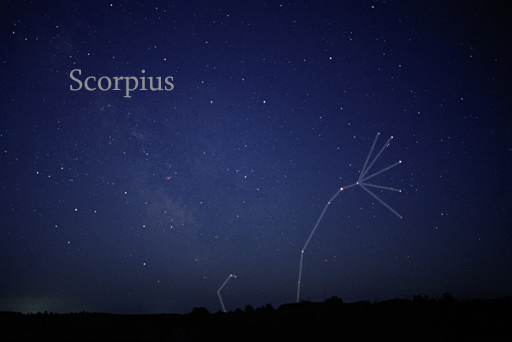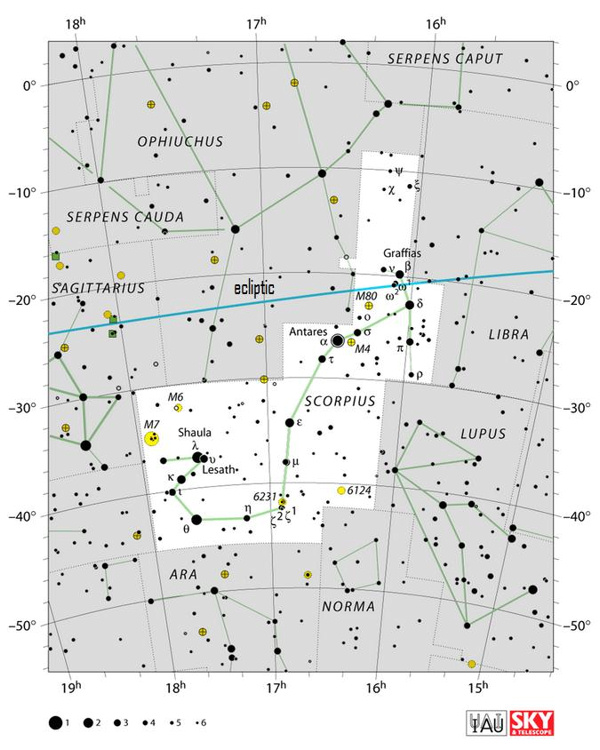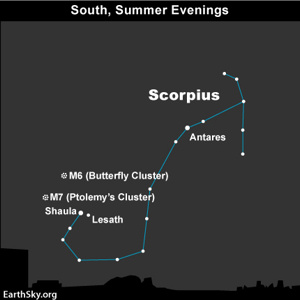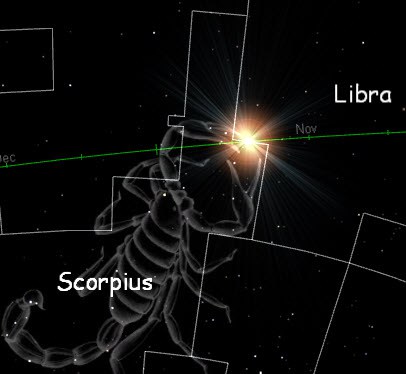

Scorpius, via Constellation of Words.
Scorpius the Scorpion – the southernmost constellation of the Zodiac – is a major showpiece of the starry sky. This J-shaped assemblage of stars actually looks like its namesake. The red star Antares is fortuitously placed in the sky just where the Scorpion’s Heart should be. What’s more, the fishhook-shaped Scorpion’s Stinger – made up of two stars, Shaula and Lesath – dips into the Milky Way’s stream of stars, allowing you to catch many a galactic treasure.

The constellation Scorpius. See the bright reddish star at the ‘heart’ of this constellation? This star is very noticeable in the night sky. It’s called Antares. Photo: Till Credner, AlltheSky.com.

Here’s a detailed view of the constellation Scorpius. Notice that very little of the constellation Scorpius goes north of the ecliptic, or sun’s path across our sky. Scorpius is the southernmost constellation of the Zodiac; Click here for larger chart.

The constellation Scorpius. From the Northern Hemisphere, it is highest up in the evening on hot summer nights of July and August. Notice the two stars at the tip of the Scorpion's Tail. They are Shaula and Lesath, also known as The Stinger.
How to locate the constellation Scorpius. For evening viewing, July and August are prime-time months for observing this wondrous constellation. In the Northern Hemisphere, we associate the ruby star Antares – or Ant-ares, the Rival of Mars – with the hot summer season. And I personally associate Antares with the blooming of wild cardinal flowers on my favorite hiking trail. As the summer season wanes, Antares’ fading into the southwestern dusk presages the cooler days of autumn.
In early July, in either the Northern or Southern Hemisphere, Scorpius climbs to its highest point in the sky at about 10 p.m. local time (11 p.m. local daylight saving time). Because the stars return to the same place in the sky about one-half earlier with each passing week, look for the celestial Scorpion in mid-July to soar highest up around 9 p.m. local time (10 p.m. local daylight saving time), and by late July around 8 p.m. local time (9 p.m. local daylight saving time).
As seen from mid-northern latitudes, such as the central U.S., Scorpius never climbs high in the sky, but rather skitters along the horizon, so you need an unobstructed view southward to see this constellation in its entirety. From northern U.S. states and most of Canada, the Scorpion’s Tail stays at least partially submerged below the horizon, but its most brilliant star Antares can be seen as far north as southern Alaska.
Antares is the Heart of the Scorpion
Shaula and Lesath: Scorpion’s stinger stars
M6 and M7: Deep-sky gems in Tail of Scorpius

The sun doesn’t spend much time in front of the constellation Scorpius each year. It’s there for about a week, between about November 22 and 29. Read more about the sun in Scorpius from Bob’s Spaces. Bob also created this illustration.
Sun’s passage in front of Scorpius. Given Scorpius’ great prominence to the eye, it’s ironic that the sun spends less time in front of the Scorpion than any other constellation of the zodiac. Each year, the sun shines in the constellation Scorpius for a week, from about November 22 through November 29. If these dates seem to be in conflict with what you read on the horoscope page, remember that astrologers are referring to the sign Scorpio, not the constellation Scorpius.
Sun’s entry into each constellation of the zodiac
When the sun reaches a point on the ecliptic that’s 30 degrees to 60 degrees east of the September equinox point, then the sun is said to be in the sign Scorpio – irrespective of which constellation or constellations backdrop the sun at this period of time. The sun passes through the sign Scorpio (not the constellation Scorpius) from about October 23 to November 21, even though the sun is actually in front of the constellations Virgo and then Libra during this same stretch of time.
The astrological signs remain fixed relative to the solstice and equinox points. But, in the sky, these seasonal markers slowly but surely shift westward relative to the constellations, or backdrop stars. Some five thousand years ago, for instance, the star Antares marked the Northern Hemisphere’s autumnal equinox point. In our day, Antares and the sun have their annual conjunction on or near December 1 – some three weeks before the December 21 solstice. Antares will mark the December solstice point some 1,500 years into the future.
The International Astronomical Union (IAU) decreed the boundaries of the 88 official constellations in 1930, and the sun has been destined to spend only a week in front of Scorpius yearly ever since. As the boundaries are presently defined, the sun spends close to three weeks in front of the constellation Ophiuchus (November 29-December 18), the constellation immediately north of Scorpius. Note on the sky chart above that the IAU chose to draw most of the Ophiuchus-Scorpius border to the south of the ecliptic – the sun’s yearly pathway in front of the stars. Had the IAU chosen to draw the border to the north of the ecliptic, then the sun’s duration within Scorpius would be closer to one month.
Early astronomers used key stars and easy-to-recognize star patterns (constellations) to track the motions of the sun, moon and planets upon the zodiac. That being the case, olden astronomers were probably more inclined to use the “fixed” stars of Scorpius than of Ophiuchus for referencing the whereabouts of the wandering planets. After all, the ancients watched the red planet Mars pair up with the ruddy star Antares in recurring cycles, and it’s no wonder that Antares was given the appellation “the rival of Mars.” Moreover, the moon routinely occults – passes in front of – Antares at certain stages in the moon’s 18.6-year cycle, although the next series of Antares ocultations won’t begin until August 25, 2023.

In the skylore, and in the real sky, Scorpius (left) and Orion (right) are never seen in the sky at the same time. Illustration from a project by Hyaku at behance.net.
Scorpius in mythology. According to star lore, the Scorpion’s stinger brought about the death of Orion the Mighty Hunter. So when the gods gave the Scorpion and Orion their final resting places in the high heavens, they made sure to place the archenemies at opposite ends of the sky. That’s why you can never see these two constellations in the same sky together. To this day, Orion only rises in the east after Scorpius sets in the southwest, and the reverse is also true: Scorpius won’t rise in the southeast until Orion’s departure in the west.
From either the Northern or the Southern hemisphere, July is the month for Scorpius the Scorpion to reign supreme and for Orion to take his place in the underworld. But six months before or after – in the month of January – Orion has his turn to lord over the nighttime sky.
Bottom line: The constellation Scorpius is easy to pick out with the eye, because it looks like its namesake.
Taurus? Here’s your constellation
Gemini? Here’s your constellation
Cancer? Here’s your constellation
Leo? Here’s your constellation
Virgo? Here’s your constellation
Libra? Here’s your constellation
Scorpius? Here’s your contellation
Sagittarius? Here’s your constellation
Capricornus? Here’s your constellation
Aquarius? Here’s your constellation
Pisces? Here’s your constellation
Aries? Here’s your constellation
Birthday late November to early December? Here’s your constellation





















